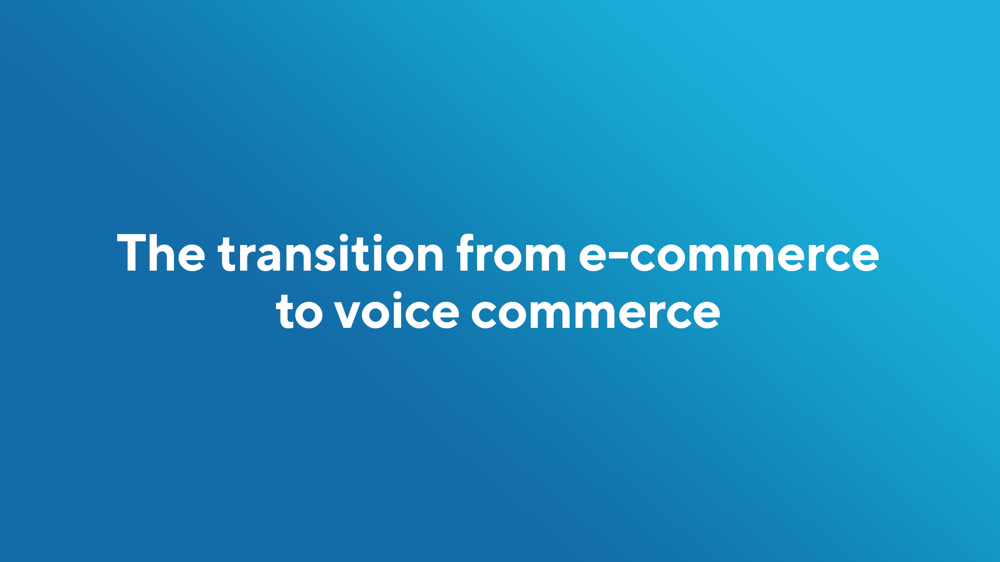The transition from e-commerce to voice commerce
VOICE Talks 21-09-23 Modev Staff Writers 4 min read

Artificial intelligence and voice technology are becoming ubiquitous. They are transforming how we go about our daily lives and spurring significant economic growth across many industries. One such industry is e-commerce.
E-commerce, which brought shopping online, already transformed the shopping experience itself just a few years ago. Now, AI-enabled voice tech is transforming e-commerce into voice commerce.
As its name states, voice commerce is a technology that enables users to shop and make online purchases through a voice interface rather than using a mouse, keyboard, or touch screen. And it seems to be winning consumers over. In 2021, voice commerce grew to represent $4.6 billion. And it’s expected to reach $19.4 billion or more in 2023. That means 320% growth. Not bad, right?
According to voicebot.ai and Voysis’ joint Voice Shopping Consumer Adoption Report, the top three reasons consumers are embracing voice shopping are:
- It’s hands-free
- You can do other things at the same time
- It’s faster to get answers and results
Walmart is betting on voice commerce
Large retailers are aware of this trend. Walmart, for example, has partnered with Google to enable users to purchase its products using Google Assistant. Beyond that, Walmart allows its users to link their Walmart and Google Express accounts. This linking provides Google with a Walmart shopper’s purchases list, allowing them to repurchase products they previously bought quickly and easily. All of this using only voice.
As Marc Lore, CEO of Walmart’s e-commerce division, says, “Voice is the next big way for us to be able to leverage data from a person’s car, home, or device. It will allow them to shop in a very conversational way with a robot, in the same manner they would with a specialist on a showroom floor of a retailer.”
Walmart isn’t the only large retailer jumping on the voice commerce bandwagon. Earlier this year, Amazon enhanced its voice assistant, Alexa, with new features revolving specifically around voice commerce: Alexa Shopping Actions.
Amazon and Google get ready for the voice commerce boom
Alexa Shopping Actions allow third-party Alexa developers to prompt users to purchase any product sold through amazon.com within their skill itself. When a skill offers a user an opportunity to purchase a product, the user can ignore or reject the prompt, and the skill continues with its normal routine. If, however, the user accepts the offer, Alexa guides them through the entire purchasing process until the order is placed and confirmed. After that, the user is returned to the active skill at the exact point they left off.
Being acutely aware of this voice commerce’s massive growth potential, Amazon needed to make sure that the rollout of its Alexa Shopping Actions was smooth and didn’t overburden Alexa developers. To that end, it developed what it calls Shopping Templates. An Amazon spokesperson described Shopping Templates this way:
“To make it easy for developers to design a shopping experience with Alexa Shopping Actions, we are launching Shopping Templates (including ‘recommend a product’, ‘browse multiple products’, ‘find a product’). Shopping Templates encapsulate Amazon-designed, tried-and-tested, dialog patterns and responses that a developer can plug-in and customize [for their] skill.”
Google has also developed Shopping Actions for its platform, enabling merchants to sell products directly through Google Search and Google Assistant. The idea is to keep shoppers within the Google ecosystem rather than handing them off to the competition for the actual purchases. It’s clear that the voice tech industry is aware of the opportunity voice commerce represents.
Growing up with voice grows voice
There’s no doubt voice shopping will continue to be promoted and to grow. More and more new devices are voice-enabled by default. And as that expectation grows, so will the use of voice assistants, particularly among the younger generations. Case in point, here’s a breakdown of voice shopping users by age group, again, taken from voicebot.ai and Voysis’ joint Voice Shopping Consumer Adoption Report:
- Ages 18-29: 34.5%
- Ages 30-44: 21.3%
- Ages 45-60: 12.9%
- Ages 60 and above: 11.1%
The younger you are when you experience something, the likelier you are to repeat that experience as an adult. That fact informs the above statistics and clearly makes a case for sustained growth of voice commerce. As today’s youth starts to experience voice commerce, tomorrow’s adults will be seasoned users. That’s growth.
Learn more about voice commerce with VOICE Talks
“VOICE Talks,” a monthly live-streamed talk show discussing the latest developments in voice technology, announced that its September 30 episode will share “How Conversational AI is Revolutionizing E-Commerce.”
Subscribe to watch the next episode of VOICE Talks live on September 30 at 2 p.m. ET / 11 a.m. PT. Previous episodes can be viewed on the VOICE Talks Youtube channel.
About VOICE Talks
Produced by Modev and presented by Google Assistant, the award-winning VOICE Talks is the fastest-growing internet technology show featuring industry leaders discussing the latest developments relating to AI-powered voice technologies. Developers, marketers, gamers, and voice tech enthusiasts can tune in live or share their video stories in advance with the show’s host. Subscribe at www.voicetalks.ai or follow @VOICETalksAI on Twitter, @VOICETalks on Instagram, Facebook, or LinkedIn.